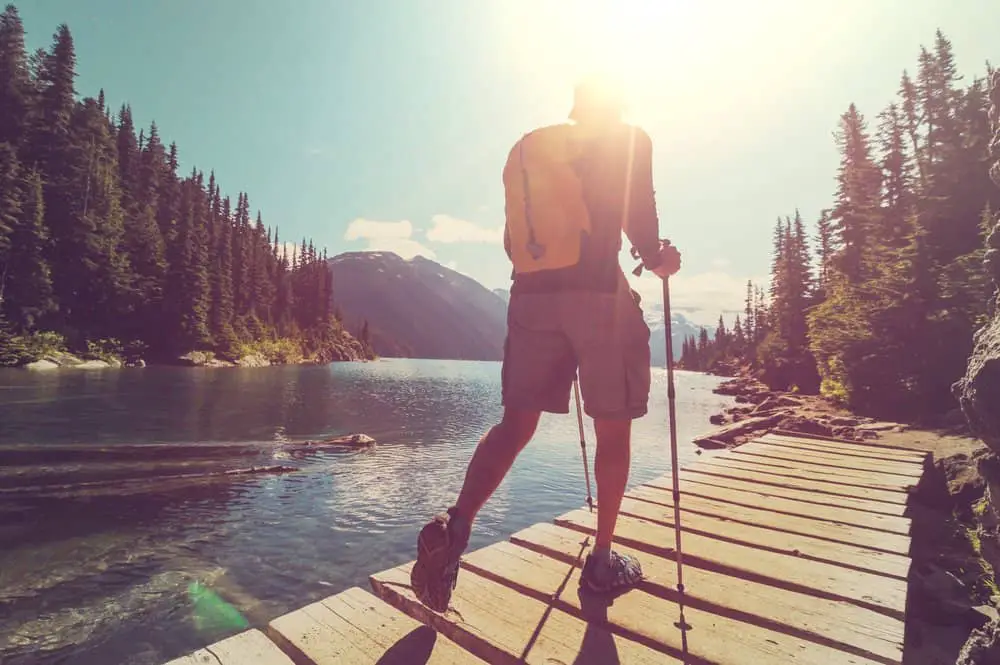What To Wear When Hiking in Summer: The Ultimate Guide

Depending on where you live, hiking in the summer can be scorching hot, cold, or somewhere in-between. For the purposes of this article, I’m going to assume it’s the first option. Summer is well underway here in Texas, meaning the heat and humidity are out in full force.
So when it comes to hiking in hot, sweaty, and sticky weather, what are your options? What do you wear when hiking in the summer heat? Are there certain materials better suited for hiking in hot weather? In this article, we’ll discuss a few tips on what to wear when hiking in summer, as well as some must-have accessories for hot-weather hikes.
Quick Links
Is It Safe to Hike in The Summer?
First off, I wanted to address some safety concerns for summer hikes. Like I said, depending on where you live, the summer heat can be absolutely brutal.
I moved from New York to Texas a few years ago now, and let me tell you, the heat here is no joke. It’s not uncommon for temperatures to reach above 100 degrees Fahrenheit, with humidity levels upwards of 70%. As of writing this article, the temperature is expected to hit 101 degrees later this afternoon. When I first moved here to Texas, I was told that Texas summers are like New York winters – meaning you should probably just stay home.
Does this mean you can’t hike during summer in blistering heat? Not necessarily; you just need to be smart about it. In these conditions, it’s essential to be aware of the dangers of heat-related illnesses, such as heat exhaustion and heat stroke.
With that said, there are definitely go-to materials and gear choices that can help make your hike in the summer heat more bearable, and I’ll touch on that next.
9 Essential Accessories for Hiking in The Summer
Before we get into the different types of clothing material, let’s first go over some essential accessories for summer hikes. These are items that will help keep you cool, comfortable, and protected from the sun while hiking in hot weather.
1. Sunglasses
I was never a big fan of sunglasses, but I quickly realized how important they were once I moved to Texas. Not only do they help protect your eyes from the sun’s harmful UV rays, but they can also help reduce glare.
And it’s not just sun protection you need to worry about; sunglasses can also help protect your eyes from debris, dust, and insects. In fact, one of the most common hiking annoyances is debris and dust getting into your eyes. So definitely don’t forget your sunglasses.
Recommendation: The Julbo Camino Mountain Sunglasses are a fantastic choice. They aren’t the most stylish, but they do the job well. The tint and UV blocking technology is top-notch. They’re comfortable to wear for long periods and have excellent side coverage with removable side shields, which is pretty unique for sunglasses.
2. Sunscreen
Another essential item for any summer hike is sunscreen. Even if you don’t plan on spending too much time in the sun, it’s always better to be safe than sorry. As I’m sure you know, the sun’s UV rays can be extremely harmful, causing sunburns, skin damage, and even skin cancer. So it’s important to lather up before heading out on your hike.
3. Bug Spray
Another essential item for any summer hike is bug spray. Depending on where you live, all sorts of insects come out in the summertime, most of which love to bite. So it’s essential to have some sort of bug protection before heading out on your hike. Typically, any bug spray with DEET will do the trick.
4. Sun hat
A brimmed hat, or a sun hat, is another essential item for any summer hike. Not only does it protect your face from the sun, but it can also help keep insects away from your head. And let’s be honest, a sweaty forehead is never fun. And a good hat will do more than just cover your eyes. It should be able to protect your neck and parts of your chest.
5. Water and Reusable Water Bottles
This one is pretty self-explanatory, but it’s worth mentioning. When hiking in the summer heat, it’s important to stay hydrated. So make sure you bring plenty of water with you, and even more importantly, make sure you drink it.
I like to bring at least 2 liters of water with me on any hike, but I’ll often bring 3 liters in the summer heat. And if you’re hiking in a really remote area, it’s always a good idea to bring a water filter as well. You can filter more from a stream or river if you run out of water.
Recommendation: I just recently bought a TAL Stainless Steel Insulated Water Bottle – and it is incredible. I’ve had ice remain frozen overnight in a warm room with the cap open. My water has consistently stayed ice-cold for more than 24 hours. I used to use a HydroFlask, which was still good, but honestly can’t hold a candle to this thing. I’ve been so impressed by this TAL water bottle that I will write a full in-depth review one of these days.
6. Salty Snacks
Food is fuel for your body, and when hiking in the summer heat, you’re going to need all the fuel you can get. So make sure you bring plenty of snacks with you. I like to bring salty snacks like nuts and jerky because they help replenish electrolytes lost through sweating.
7. First Aid Kit
The key to effectively dealing with all possibilities is preparation, and nothing shows preparation more than having a first aid kit ready for your hiking trip. Stick to the basics, focus on essentials, and do your best to keep your bag as light as possible.
8. Hiking Shoes or Trail Runners
Typically, the shoes you wear for your hike depend on the terrain you cover. If you’re expecting to come across a lot of rocks and uneven gravel, then you want a shoe with good ankle support and toe protection, which will typically be hiking shoes or boots.
For less technical trails, a lighter trail runner might be more appropriate. However, when it comes to summer hiking, I prefer to wear something lighter, such as trail runners or hiking shoes, and ditch the boots.
9. Breathable, Moisture-Wicking Socks
This may seem like a small thing, but having the right socks can make a big difference on your hike. If you’re hiking in hot weather, you want socks that will wick away sweat and keep your feet dry. Take it from me, having wet and sweaty socks in your hiking shoes all day is unpleasant and can lead to things far worse than just discomfort.
I developed a bad fungal infection on my feet about five or six years ago because of sweaty socks that I kept on for too long. The fungal infection (athlete’s foot) lasted almost two years and was incredibly difficult to get rid of. Nothing I tried seemed to work except for time. And two years is a VERY long time when you have athlete’s foot.
Recommendation: I suggest merino wool socks, as they’re my favorite for moisture-wicking properties. Check out these merino wool socks on Amazon.
Summer Clothing Materials: Do’s and Dont’s
Hiking wear comes in various shapes and sizes. In summer, certain clothing materials are essential due to the hot weather and other peculiarities that come with that time of the year. A major determinant of clothing suitable for summer is the material used in its production. Different materials have different peculiarities. These peculiarities should go a long way in helping you decide which clothes to wear. Some of the best materials for summer hiking outfits include:
Polyester
Polyester was discovered in the 1940s; since then, it has been a groundbreaking discovery in the textile industry. Polyester is a durable fabric that can withstand high temperatures. It’s also moisture-wicking and keeps you feeling dry during the summer heat. However, because of the synthetic nature of this material, it’s not as breathable as some of the others on this list.
Merino Wool
Merino wool is a type of wool that comes from merino sheep. The advantage of merino wool over other types of wool is that it’s much finer, making it softer and more comfortable to wear. Merino wool is also excellent at regulating body temperature, making it ideal for both hot and cold weather. And it doesn’t hold onto odors, so you don’t have to worry about smelling bad after a long day on the trail.
Lastly, it has excellent moisture-wicking properties, which is essential for summer hiking. I always bring at least one pair of merino wool socks with me on my hikes. (I specify one – because, on occasion, I’ll wear multiple pairs of socks while hiking.)
The one downside to merino wool is that it’s a bit more expensive than some other materials on this list. But, in my opinion, it’s worth the extra cost.
Nylon
Nylon was first introduced in the 1930s and has since become one of the most popular materials used in clothing production. Nylon is lightweight, strong, and dries quickly – making it an excellent choice for summer hiking gear. However, compared to polyester, nylon doesn’t dry out as quickly, so it’s not quite as good at wicking away sweat.
However, nylon is a bit more breathable than polyester, making it a bit more comfortable to wear in the heat.
Denim
Denim is a cotton twill fabric that is often used in jeans production. Denim is a thick fabric, making it durable and perfect for cold weather. However, for summer hiking wear – don’t bother. Denim is terrible for summer hikes. If you’re considering hiking in jeans, for example, don’t. Just don’t.
Cotton
Cotton is a natural fabric that is derived from the cotton plant. Cotton is a soft and breathable fabric, making it seemingly great for summer hiking wear. However, there are a few disadvantages to cotton. First, it’s not as durable as some of the other materials on this list. Second, it doesn’t wick away moisture as well as some of the others – so you’ll likely end up feeling a bit wetter than you would with, say, polyester or nylon.
But if the sun is really beating down on you hard, and you’re sweating profusely – cotton can be downright dangerous. When cotton gets wet, it tends to stay wet. It’ll become heavy, miserable, and will actually make you feel hotter. So, while cotton might be comfortable when it’s dry – it’s not the best choice for summer hikes.
The Final Verdict on Clothing Material for Summer Hiking
So, what’s the best clothing material for summer hiking? In my opinion, it’s a tie between polyester and nylon. They’re both lightweight, strong, and quick-drying – perfect for hot summer days. However, nylon is a bit more breathable than polyester – so if you’re looking for the most comfortable option, nylon is the way to go.
Another thing to note is that most outdoor clothing you’ll find is usually a mix of multiple materials. So, you might see a shirt that’s made from 60% polyester and 40% nylon. These blends can take the best properties of both materials and create a garment that’s perfect for summer hikes. A mix of polyester and nylon is also usually a good bet.
5 Tips for Hiking Safely in The Summer
Lastly, I wanted to cover a few tips for hiking safely in the summer. These tips are essential, especially if you’re new to hiking or if you don’t hike often.
1. Start Early
One of the best things you can do when hiking in the summer is to start early. I’m talking sunrise early. By starting your hike early, you’ll avoid the hottest part of the day. And, if you start early enough, you might even be able to avoid the heat altogether – and the crowds.
2. Bring Plenty of Water
This one should be a no-brainer, but I still see people hiking in the summer without enough water all the time. When hiking in the summer, always bring more water than you think you’ll need. And, if possible, bring more water than that. As a baseline, you should be drinking at least a liter of water per hour – more if it’s hot out.
3. Dress Smart and Light
Let your focus be on comfort and breathability when picking out your clothes for a summer hike. Don’t wear anything too baggy, or you’ll risk getting overheated. And, always err on the side of dressing too light – you can always take layers off if you get too warm, but you can’t put them on if you don’t have them.
4. Apply and Re-Apply Sunscreen
This one is important! Don’t forget to apply sunscreen before your hike, and don’t forget to re-apply it often. Even if you don’t think you’re sweating that much, sunscreen will still come off – so be sure to reapply it every few hours.
5. Take Breaks Often
When it gets hot out, take more breaks than you normally would. Find a shady spot, sit down, and take a few minutes to relax and drink some water. It’s important to stay hydrated and cooled down – so don’t push yourself too hard. Pace yourself!
Conclusion
Hiking in the summer should be fun, scenic, and, most importantly – safe. By following the tips in this article, you’ll be well on your way to having a great time on the trails – no matter how hot. So get out there and enjoy the summer sun!






